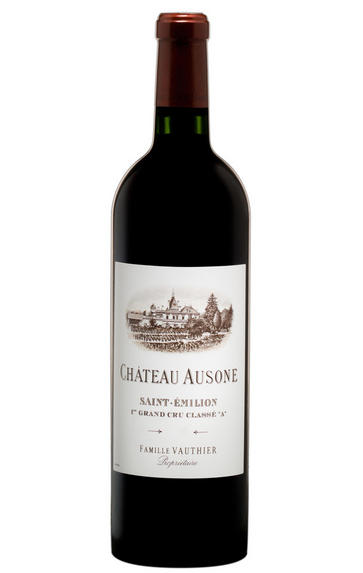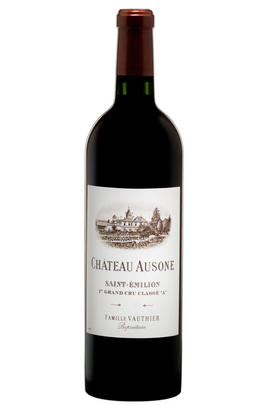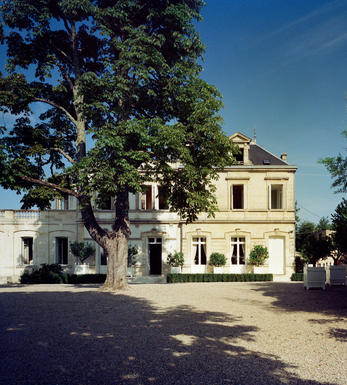
2005 Chapelle d'Ausone, St Emilion, Bordeaux

Critics reviews
Robert M. Parker, Jr. - 29/06/2015
Jancis Robinson - www.jancisrobinson.com - 18-Apr-2006
Robert Parker eRobertParker.com #219 Jun 2015
About this WINE

Château Ausone
Château Ausone is a wine estate in St Emilion on the Right Bank of Bordeaux. It takes its name from the poet Ausonius, who is thought to have owned a villa where the estate stands today – just outside the medieval village of St Emilion. Ausone’s vineyards sit atop St Emilion’s limestone plateau and extend in terraces down the côtes. There are just over six hectares of vines planted today, mostly Cabernet Franc along with Merlot. The team practice organic and biodynamic viticulture though without certification.
The estate belongs to the Vauthier family, led by Alain Vauthier and his children, Pauline and Edouard. In 1955, Ausone was ranked at the very top of the St Emilion classification – as Premier Grand Cru Classé A – alongside Château Cheval Blanc. In 2021, both Ausone and Cheval Blanc announced that they were voluntarily withdrawing from the classification.
Ausone is known for its structured, long-lived wines. A second wine, Chapelle d’Ausone, was introduced in the 1990s. The Vauthier family also own a number of other properties nearby in St Emilion, including Château Moulin Saint-Georges, Château La Clotte and Château de Fonbel.

St Émilion
St Émilion is one of Bordeaux's largest producing appellations, producing more wine than Listrac, Moulis, St Estèphe, Pauillac, St Julien and Margaux put together. St Emilion has been producing wine for longer than the Médoc but its lack of accessibility to Bordeaux's port and market-restricted exports to mainland Europe meant the region initially did not enjoy the commercial success that funded the great châteaux of the Left Bank.
St Émilion itself is the prettiest of Bordeaux's wine towns, perched on top of the steep limestone slopes upon which many of the region's finest vineyards are situated. However, more than half of the appellation's vineyards lie on the plain between the town and the Dordogne River on sandy, alluvial soils with a sprinkling of gravel.
Further diversity is added by a small, complex gravel bed to the north-east of the region on the border with Pomerol. Atypically for St Émilion, this allows Cabernet Franc and, to a lesser extent, Cabernet Sauvignon to prosper and defines the personality of the great wines such as Ch. Cheval Blanc.
In the early 1990s there was an explosion of experimentation and evolution, leading to the rise of the garagistes, producers of deeply-concentrated wines made in very small quantities and offered at high prices. The appellation is also surrounded by four satellite appellations, Montagne, Lussac, Puisseguin and St. Georges, which enjoy a family similarity but not the complexity of the best wines.
St Émilion was first officially classified in 1954, and is the most meritocratic classification system in Bordeaux, as it is regularly amended. The most recent revision of the classification was in 2012

Cabernet Sauvignon Blend
Cabernet Sauvignon lends itself particularly well in blends with Merlot. This is actually the archetypal Bordeaux blend, though in different proportions in the sub-regions and sometimes topped up with Cabernet Franc, Malbec, and Petit Verdot.
In the Médoc and Graves the percentage of Cabernet Sauvignon in the blend can range from 95% (Mouton-Rothschild) to as low as 40%. It is particularly suited to the dry, warm, free- draining, gravel-rich soils and is responsible for the redolent cassis characteristics as well as the depth of colour, tannic structure and pronounced acidity of Médoc wines. However 100% Cabernet Sauvignon wines can be slightly hollow-tasting in the middle palate and Merlot with its generous, fleshy fruit flavours acts as a perfect foil by filling in this cavity.
In St-Emilion and Pomerol, the blends are Merlot dominated as Cabernet Sauvignon can struggle to ripen there - when it is included, it adds structure and body to the wine. Sassicaia is the most famous Bordeaux blend in Italy and has spawned many imitations, whereby the blend is now firmly established in the New World and particularly in California and Australia.


Buying options
Add to wishlist
Description
The second wine of Ausone, the Chapelle dAusone, usually represents about 50% of the production from this tiny historic vineyard. The 2005 has a dense minerality, sweet blueberry and blackberry fruit, and plenty of flowers and crushed rock in a full-bodied, stunningly concentrated style. Amazingly, this second wine is probably better than many of the great Ausones from the 1940s, 50s, 60s, 70s and early 80s! Drink it over the next 30+ years.
Robert M. Parker, Jr. - 29/06/2015
wine at a glance
Delivery and quality guarantee